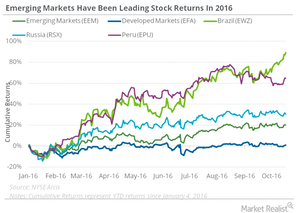Emerging Markets Have Been Leading Stock Returns in 2016
While developed markets have been caught in a lull, we’ve seen emerging markets grab the spotlight. Emerging markets have been leading stock market returns so far in 2016.
Nov. 22 2019, Updated 6:14 a.m. ET

Economic and political uncertainty impacted developed markets
Uncertainty and volatility seem to have become characteristics of the developed markets over the past two years, led by the following factors:
- oil price plunge and uncertainty over the general election results impacting the US economy
- Brexit vote impacting the European economy
- strengthening yen adding to deflation in Japan despite constant policy measures
While developed markets have been caught in a lull, we’ve seen emerging markets grab the spotlight. Emerging markets have been leading stock market returns so far in 2016.
Emerging markets have been outperforming
The chart above shows the performance of the iShares MSCI Brazil ETF (EWZ), which has risen more than 70% since the beginning of 2016. The VanEck Vectors Russia ETF (RSX) has returned over 24% to investors so far this year. The iShares MSCI All-Peru Capped ETF (EPU) is also placed among the winners with a YTD (year-to-date) return over 60% on November 2.
Among the other emerging markets, India has an ~7% return, as gauged by the performance of the WisdomTree India Earnings ETF (EPI). China follows with the iShares China Large-Cap ETF (FXI) returning 3.7% YTD.
With respect to developed markets, US equities (SPY) returned ~2.9% on November 2. On that day, Europe (VGK) fell ~7% and Japan (EWJ) rose 3.2% YTD.
Consequently, the iShares MSCI Emerging Markets ETF (EEM) rose 13% with respect to developed markets (EFA), which are down 2.6% YTD.
